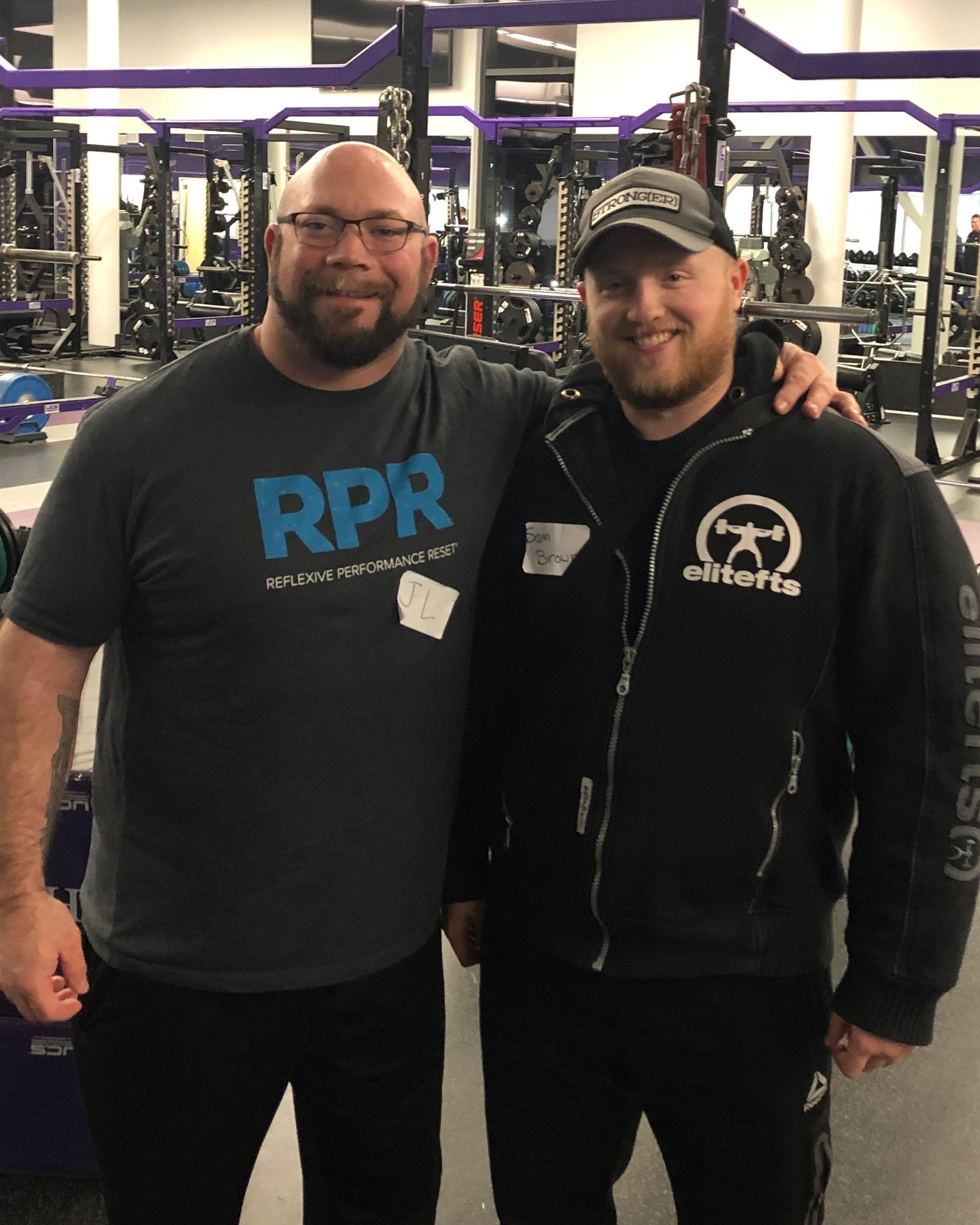This is a contribution from Sam Brown of Sam Brown Strength in Rhode Island. Sam’s got a really special background combining strength with a background as a mental health clinician. He’s a great follow on Instagram.
Advice to a New RPR Specialist
JL and Sam at Holy Cross
Neal Dakmak giving Breaux a little RPR intro. Sam’s not the only one!
With the recent introduction of the RPR level one online course, I have seen quite a rise in the amount of coaches and athletes who understand just how game changing the RPR Wake-Up Drills are for performance. It is beyond exciting to see the new faces in the RPR community each week and the cool new places utilizing RPR to boost performance.
That being said, if you have recently completed a Level 1 clinic you usually find yourself in one of two camps. The first one is the “Holy-Cow-I-am-showing-this-to-everyone-I-know” camp. I was and am still firmly planted here. I have successfully shown every family member, athlete, client, friend, and pet I know the wake up drills and the amazing power one can obtain when breathing correctly. I could not get enough of teaching people what I learned and educating them in how simply they can gain control of their stress and better control their performance. See? I am doing it now too...
The other camp is the “I-know-what-learned-was-amazing-but-how-do-I-teach-this-and-not-look-dumb-or-mess-up” camp. I totally understand that feeling. Learning RPR was both life changing and intimidating. It is how you decide to act in that moment that will truly decide what you get out of that personal investment.
In order to help the newcomers to the RPR system, I have come up with a few tips and strategies that you can utilize to help implement RPR into your program, your facility, your team, or your clients.
Tip 1: Practice Practice Practice (on yourself and with others)
Just like with anything else, the more you perform and teach the Wake-Up Drill the easier they are to perform and to teach. I found that the more I personally performed the wake up drills on myself, the better I could identify and describe the specific spots and how they feel to the athletes or clients.
If you are worried about messing up or not doing it “right”, do not fret because you will definitely screw up, forget a step, or not do it exactly like you have learned it and that’s ok. The goal of RPR is not to be perfect but rather focus on progress. Each time you teach a new person the wake up drills, what spots to hit, and how to breathe you will get better and better. Just keep putting the time in and the confidence and skill will develop.
Tip 2: Capture Attention/Build Buy In
The biggest thing I have found to help teach the Wake-Up Drills is to capture your audience’s attention with a test and retest of a particular Wake-Up Drill. In the demonstrations with my baseball athletes, I always take them through proper breathing and Zone 1. Seeing the athlete’s faces when they can actually feel their glutes firing is pretty cool. You can see the wheels turning in their head on how this drill will help with their power at the plate or from the mound. From this point forward, they are all ears and want to learn more this is also where the “This is voodoo” or “What’s the trick?” and the “Me next!” starts flying around.
This might be different for you or your particular clients. The key is to capture their attention and interest, then spend the time explaining things to them further. This is especially true for teaching younger athletes. It is hard enough to get the attention of 12-16 year olds for longer than 6 seconds so you need to make sure you are able to utilize the small span of time when you have their focus and attention.
Tip 3: Avoid the “Guru” Route
One of the best pieces of advice I received from Jeff Bramhall about how best to teach RPR to larger groups and individuals is to always focus on the athlete or group of athletes performing the drills for themselves and on themselves. One of the reasons RPR is so versatile and effective is because it does not require a trained practitioner to touch the clients. It empowers the athletes and clients to work on themselves and puts the tools of change into their own hands.
Sam’s squad in action
Since they do not need to see you to feel better, you can have a wider range of reach with the same results whether you are working with one person or an entire team. It is the best way to multiply your efforts and help the most amount of people that you can. This tip has been invaluable to me in being able to reach a greater audience and outcome with the same amount of effort.
No matter where you find yourself after your RPR clinic, the power is in YOUR hands. It is your responsibility as a coach to share this information with your teams, athletes, or clients. As you learned in the RPR clinic itself, it is all about progress - not perfection. Do not be afraid to fail. Be afraid of not learning and growing from the failure. We are always working to become better coaches and trainers, which requires time and daily practice. Get out there and start sharing what you have learned!



